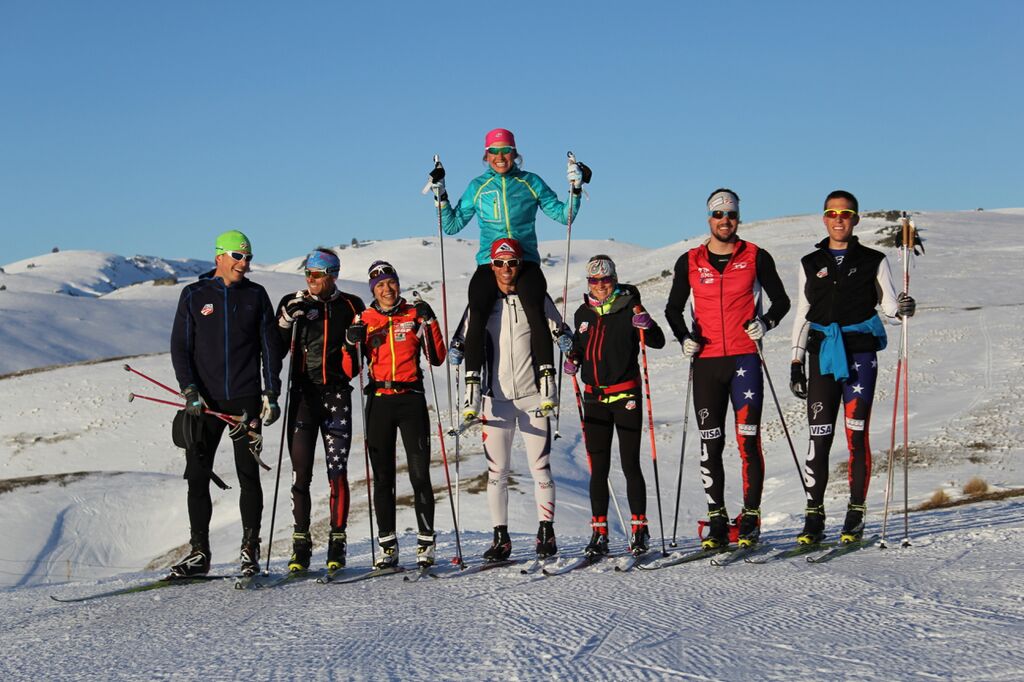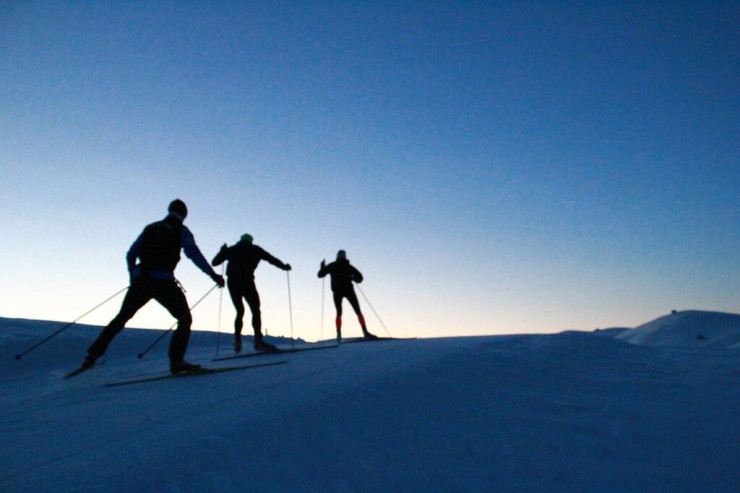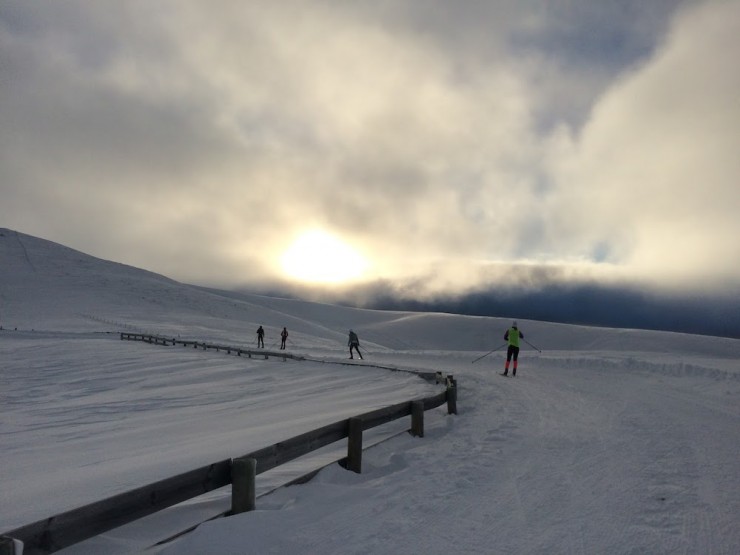
Component of the U.S. Ski Team contingent in New Zealand. From left to correct: Matt Whitcomb, Andy Newell, Anouk Faivre Picon (of France), Sophie Caldwell (leading), Noah Hoffman (bottom), Liz Stephen, Ben Saxton, and Paddy Caldwell (Photo: Simi Hamilton)
On July seven, the U.S. Ski Crew (USST) headed south to the Snow Farm in Wanaka, New Zealand, for its first on-snow camp of the offseason. Normally the crew would have logged some spring skiing in Could in Bend, Ore., but minimal-snow problems at Mt. Bachelor led the USST to cancel its yearly camp there. Alternatively, the staff relied on its mid-summertime trip to the Southern Hemisphere to make up for the lost time on snow.
“One purpose we felt it was essential to go to New Zealand this 12 months was that we weren’t capable to have our classic camp at Mt. Bachelor,” USST Head Coach Chris Grover said on the phone. “We needed to have a longer on-snow camp than we have had the final couple of years in the middle of the summer time to try and make up some of those missed days on snow.”
9 USST athletes and 3 coaches from the decrease 48 reported to camp — with A-team members Andy Newell, Simi Hamilton, Liz Stephen, Jessie Diggins, Sophie Caldwell, and Ida Sargent, B-staff member Noah Hoffman, D-teamers Paddy Caldwell and Ben Saxton, as effectively as ladies’s coach Matt Whitcomb, assistant coach Jason Cork, and Grover. French World Cup skier Anouk Faivre Picon also joined the group.
Of the 16 skiers nominated to the USST this spring, most of individuals who didn’t make the New Zealand journey educated with the Alaska Pacific University (APU) Elite Group in Anchorage. Alternatively, they had 3 shorter on-snow camps planned for Eagle Glacier, in which the USST held a camp last summer time and exactly where a number of of the USST females have returned each year since 2011 for the North American Females’s Instruction Alliance.

The U.S. Ski Staff females in New Zealand plus France’s Anouk Faivre Picon (l). From left to right: Liz Stephen, Jessie Diggins, Ida Sargent, Sophie Caldwell. (Photo: Sophie Caldwell)
For the athletes in Alaska, it is easy to take benefit of Eagle Glacier’s location. But for everyone else, a longer journey to New Zealand created more sense this 12 months, Grover explained.
“Alaska is great, but Eagle Glacier really lends itself to about 6 days of skiing up there and then its time to come down and take a rest with the way that almost everything is set up, the way the residing situation and every thing works,” he said. “[The APU skiers] have their strategy that they get from [their coach] Erik Flora. … They are acquiring on Eagle Glacier 3 occasions: as soon as in each and every summer month, June, July, and August. I recognize it, I suggest, when you have skiing out your back door, it tends to make it a little bit hard to make the move all the way down to the Southern Hemisphere.”
But for the rest of the USST, the 15-day camp at the Snow Farm was ideal, with effortlessly accessible ski trails along a ridge and an accommodating employees prepared to groom specifically for them.
“It’s a amazing location for just focusing on training as significantly as you want and eating and sleeping and recovering in in between,” Grover said. “Typical days have been breakfast, ski for two and a half, three hrs until finally lunch, [then] lunch, a little bit of recovery time, and then an afternoon workout — that was normally skiing — and then dinner and some method evaluation and that kind of point from the day, possibly some PT [physical treatment]-variety function in the evening if essential and then to bed.”
With so a lot ski time paired with powerful recovery, the athletes accomplished a single big goal of the camp: ticking off a great deal of kilometers in on snow. Another group goal was to refine strategy to make for the type of technical instruction it would have usually done at Mt. Bachelor in Could.

Skiing into the sunrise. (Photo: Simi Hamilton)
“One issue that we spent a lot of time on down there was herringbone method due to the fact it’s not one thing you can train dryland instruction on rollerskis,” Grover said. “For the most component, it demands to be skilled on snow. The athletes also worked on strategy fundamentals, doing a good deal classic and skate skiing without having poles.”
Even though hours on snow and approach remained the principal target, the group also incorporated power and intensity into its camp.
“Every third day would be some type of intensity in the morning and then half the group would go down to Wanaka to both run, or to lift, or to do the two whereas the other half of the group may well stay up and use the tiny fitness center and ski and lift up best,” Grover explained. “As a entire, everyone is kind of creating excellent gains, some genuinely excellent gains in power occurring right now.”
The group also manufactured certain to have some entertaining. One off day, every person went to Queenstown and went go-carting. They also did a couple photograph shoots with new USST clothes sponsor L.L. Bean. Grover mentioned the group had entertaining with the typical ski camp stuff and “did a excellent work of supporting every other and taking care of every single other.”
The crew was ready to trek to New Zealand since of an enhanced spending budget from the United States Ski and Snowboard Association (USSA) and some fundraising from the team itself. Last 12 months, the crew had to forgo a camp there because of a lack of funds.
“Luckily, this year we were ready to genuinely not even consider the price range as a lot into consideration as we had in the previous year, but to do what we felt was the very best system for the staff,” Grover mentioned.

USST members enjoyed outstanding skiing conditions. (Photograph: Sophie Caldwell)
Now back in the U.S., crew members are investing time with their local clubs, continuing their summertime instruction ahead of their next USST camp in Norway. Kikkan Randall, Diggins, Caldwell, Stephen, Newell, Hamilton, and Hoffman depart for Norway on Aug. 9, where the major concentrate will be on competing in the Toppidrettsveka, a 3-day rollerski competition in Aure, Knyken, and Trondheim from Aug. 20-22, which several national teams attend.
The journey is for the a lot more seasoned World Cup athletes who are searching to gauge themselves towards the world’s greatest. “For some athletes, that just did not really match in to what they felt like they necessary to be undertaking in August whereas other people felt like they genuinely did need to have to have a measuring stick to see where they were towards the competition,” Grover stated.
Reflecting on New Zealand, Grover was positive: “It was a actually very good camp. We truly feel like we actually completed what we set out to attain with it,” he said. “I believe that athletes, everyone is coming back exhausted, understanding that they place in about as many kilometers in excellent snow situations as they could genuinely hope for.”